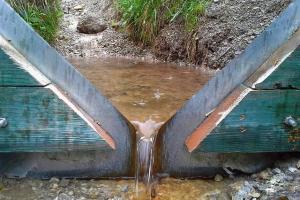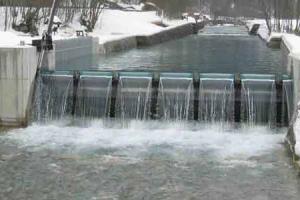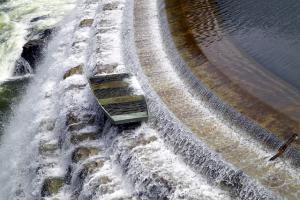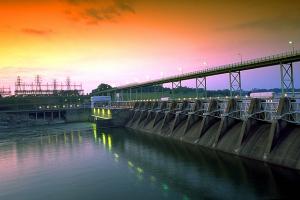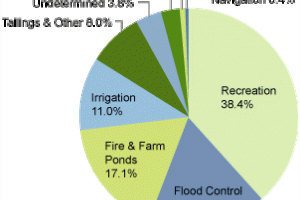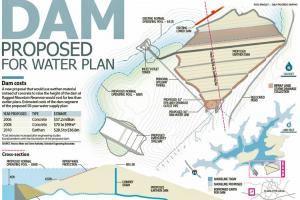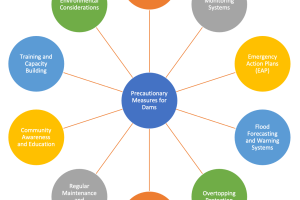Spillway - Definition, Types of Spillways and Classification
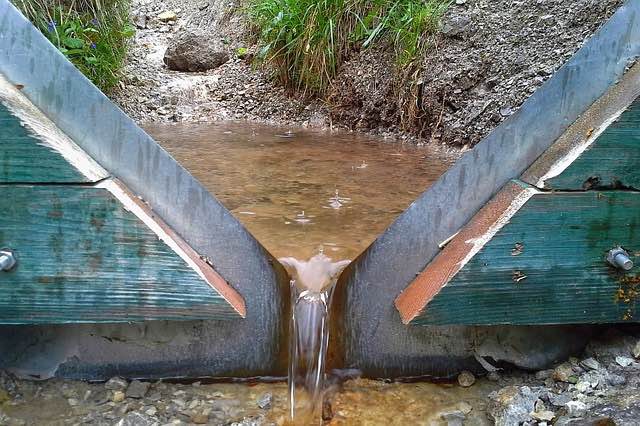
Definition:
"Spillways are structures constructed to provide safe release of flood waters from a dam to a downstream area".
Every reservoir has a certain capacity to store water. If the reservoir is full and flood water enters it, the reservoir level will go up and may eventually result in over-topping of the dam. To avoid this situation, the flood has to be passed on to the downstream and this is done by providing a spillway which draws water from the top of the reservoir. A spillway can be a part of the dam or separate from it.
Spillways can be controlled or uncontrolled. A controlled spillway is provided with gates which can be raised or lowered. Controlled spillways have certain advantages. When a reservoir is full, its water level will be the same as the crest level of the spillway.
If a flood enters the reservoir at this time, the water level will start going up and simultaneously water will start flowing out through the spillway. The rise in water level in the reservoir will continue for some time and so will the discharge over the spillway. After reaching a maximum, the reservoir level will come down and eventually come back to the normal reservoir level.

The top of the dam will have to be higher than the maximum reservoir level corresponding to the design flood for the spillway, while the effective storage available is only up to the normal reservoir level. The storage available between the maximum reservoir level and the normal reservoir level is called the surcharge storage and is only a temporary storage in uncontrolled spillways. Thus for a given height of the dam, part of the storage - the surcharge storage is not being utilized. In a controlled spillway, water can be stored even above the spillway crest level by keeping the gates closed. The gates can be opened when a flood has to be passed. Thus controlled spillways allow more storage for the same height of the dam.
Types of Spillways - Classification of Spillways
There are different types of spillways that can be provided depending on the suitability of site and other parameters. Generally a spillway consists of a control structure, a conveyance channel and a terminal structure, but the former two may be combined in the same for certain types. The more common types are briefly described below:
- Drop Spillway
- Ogee Spillway
- Siphon Spillway
- Chute or Trough Spillway
- Shaft Spillway
- Side Channel Spillway
Drop Spillway
In a drop spillway, the over flowing water falls freely and almost vertically on the downstream side of the hydraulic structure. This type of spillway is suitable for weirs or low dams. The crest of the spillway is provided with nose so that the water jet may not strike the downstream base of the structure. To protect the structure from the effect of scouring horizontal impervious apron should be provided on the downstream side. Sometimes a basin is constructed on the downstream side to form a small artificial pool which is known as water cushion. This cushion serves the purpose of energy dissipater.
Ogee Spillway
The Ogee spillway is generally provided in rigid dams and forms a part of the main dam itself if sufficient length is available. The crest of the spillway is shaped to conform to the lower nappe of a water sheet flowing over an aerated sharp crested weir.
It is a modified form of drop spillway. Here, the downstream profile of the spillway is made to coincide with the shape of the lower nappe of the free falling water jet from a sharp crested weir. In this case, the shape of the lower nappe is similar to a projectile and hence downstream surface of the ogee spillway will follow the parabolic path where “0” is the origin of the parabola. The downstream face of the spillway forms a concave curve from a point “T” and meets with the downstream floor. This point “T” is known as point of tangency. Thus the spillway takes the shape of the letter “S” (i.e. elongated form). Hence, this spillway is termed as ogee spillway.
The shape of the lower nappe is not same for all the head of water above the crest of the weir. It differs with the head of water. But for the design of the ogee spillway the maximum head is considered. If the spillway runs with the maximum head, then the overflowing water just follows the curved profile of the spillway and there is no gap between the water and the spillway surface and the discharge is maximum.
When the actual head becomes more than the designed head, the lower nappe does not follow the ogee profile and gets separated from the spillway surface. Thus a negative pressure develops at the point of separation. Due to the negative pressure, air bubbles are formed within the flowing water. These air bubbles air responsible for the frictional force (i.e. abrasion) which causes much damage to the spillway surface. Again, if the head of water is less than the designed head, the waterjet adheres to the body of the spillway and creases positive pressure which reduces the discharge through the spillway.
Chute (Trough) Spillway
In this type of spillway, the water, after flowing over a short crest or other kind of control structure, is carried by an open channel (called the "chute" or "trough") to the downstream side of the river. The control structure is generally normal to the conveyance channel. The channel is constructed in excavation with stable side slopes and invariably lined. The flow through the channel is super-critical. The spillway can be provided close to the dam or at a suitable saddle away from the dam where site conditions permit.
Side Channel Spillway
Side channel spillways are located just upstream and to the side of the dam. The water after flowing over a crest enters a side channel which is nearly parallel to the crest. This is then carried by a chute to the downstream side. Sometimes a tunnel may be used instead of a chute.
Shaft (Morning Glory or Glory hole) Spillway
This type of spillway utilizes a crest circular in plan, the flow over which is carried by a vertical or sloping tunnel on to a horizontal tunnel nearly at the stream bed level and eventually to the downstream side. The diversion tunnels constructed during the dam construction can be used as the horizontal conduit in many cases.
Siphon Spillway
As the name indicates, this spillway works on the principle of a siphon. A hood provided over a conventional spillway forms a conduit. With the rise in reservoir level water starts flowing over the crest as in an "ogee" spillway. The flowing water however, entrains air and once all the air in the crest area is removed, siphon action starts. Under this condition, the discharge takes place at a much larger head. The spillway thus has a larger discharging capacity. The inlet end of the hood is generally kept below the reservoir level to prevent floating debris from entering the conduit. This may cause the reservoir to be drawn down below the normal level before the siphon action breaks and therefore arrangement for de-priming the siphon at the normal reservoir level is provided.



